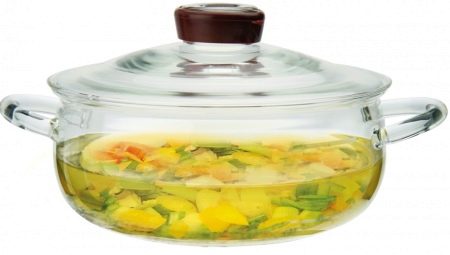Cookware in the kitchen plays an important role, therefore, for every housewife, its appearance, functionality and convenience will be of great importance. Today, along with metal pans, glass products are in demand. They are inherent in individual characteristics, which determine the increased interest in glassware in the kitchen.
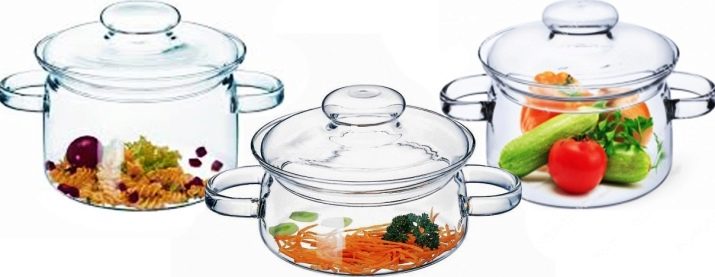
Description
Glass cookware has been used by cooks and housewives since the 19th century. The commissioning of such products with the discovery of borosilicate refractory glass is associated. Today, a lot of brands are engaged in the manufacture and sale of kitchen utensils from this material, which has a positive effect on the product range. In the manufacturing process, the material is heat-resistant pyrex glass, which is characterized by resistance to heat up to + 300С-400С.
Heat treatment of products in such containers can be carried out in ovens, microwave ovens, as well as on a conventional stove, regardless of heating options.

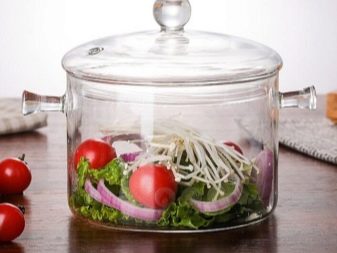
The heat resistance of the products is due to the peculiarities of the chemical composition of the glass, as well as its thickness. In addition to the size of the walls and bottom the material acquires resistance to high temperatures due to the presence of refractory compounds in the composition, their amount increases heat resistance, reducing the coefficient of expansion. But in the assortment of manufacturers there are also thin-walled glass pans.
They are designed to heat up to + 300С, which also allows you to use them in the oven, in the oven or on the stove, but due to lower thickness characteristics, such products will require more gentle handling during operation. In addition, in comparison with pots with thick glass walls, thin-walled dishes will have a lower heat capacity, which is extremely important for baking or stewing foods.
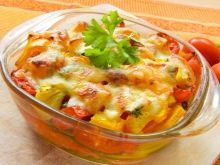
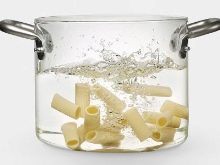
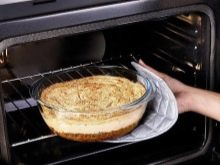
Now kitchen pans are made of transparent, brown and smoky glass, however the shade of the material does not affect its properties at all. Therefore, the choice will depend only on the personal taste preferences of the cook. Transparent products are sometimes additionally decorated with various patterns, which increases its aesthetic qualities.
Ware from the most heat-resistant glass is able to withstand heat up to + 1000С, but such raw materials as hardened are not used for the production of pots.
In addition to ordinary glass, glass ceramics can be used today to make pots.
Outwardly, it resembles porcelain, however, it is distinguished by high indicators of heat resistance, in light of which it can be used for cooking in the oven or on the stove.
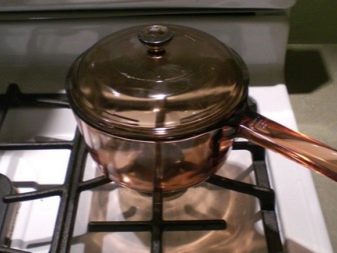
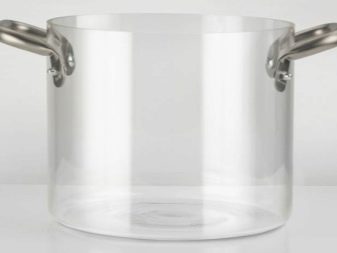
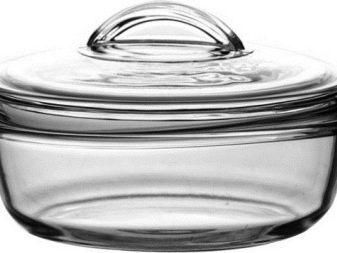
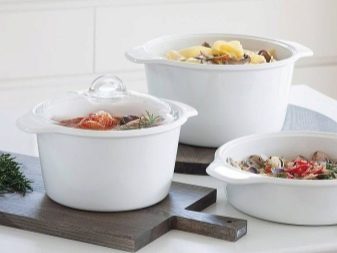
Advantages and disadvantages
Heat-resistant glass pans are very popular, but they have not been universally used in the kitchen. This is due to the presence in the dishes of strengths and weaknesses, which are manifested during operation. So, its advantages include the following.
- Some of the materials from which cookware is manufactured may react with certain types of products, thereby affecting the taste. Glass does not have such features, so the organoleptic qualities of dishes in glass pans will remain unchanged.
- A transparent or translucent glass thermal pan allows the hostess to visually control the cooking process, which is not possible in metal containers with a closed lid.
- Glass products have a universal purpose, therefore they are compatible with all types of plates. However, for induction, electric and gas burners, you will need to install a special divider.
- Glass is not susceptible to corrosion and oxidation, like many metal alloys, so dishes with proper care will not change their appearance.
- Due to the smooth surface of the glass product, it is much easier to wash, since fat and food residues are not clogged in the pores. In addition, nothing burns in the glass container. Caring for it does not require the use of any specialized compounds, in addition, the glass is perfectly cleaned in a dishwasher.
- Unlike some materials, of which most often cookware is made, glass containers can be placed in the freezer, since the glass is resistant to low temperature values.
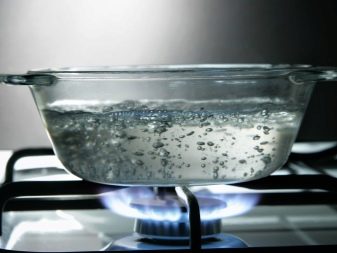
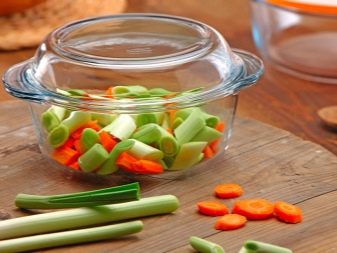
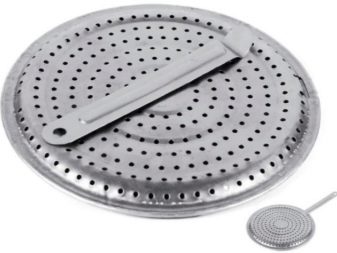
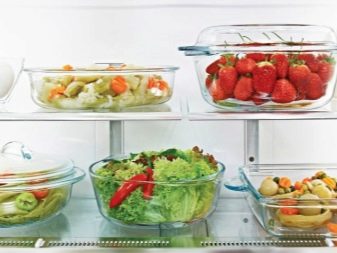
Among the minuses of such dishes, the following should be noted.
- A feature of glass is its low thermal conductivity, in light of which the cooking process may require more time than containers made of metal alloys.
- Despite the fact that pans have thick walls, they will still be more fragile. In case of careless handling, the dishes can be easily broken on a concrete or tiled floor. In addition, the container can be damaged with metal spoons, forks, etc.
- Glass containers are not resistant to a sharp jump in temperature. Therefore, immediately from the refrigerator, it is not recommended to put the pot on a hot stove or in a hot oven.
- Glass products have a large mass when compared with the usual pots of steel or lightweight aluminum.
- Capacities do not always have convenient handles, in addition, glass handles heat up with dishes, which can be inconvenient to use.
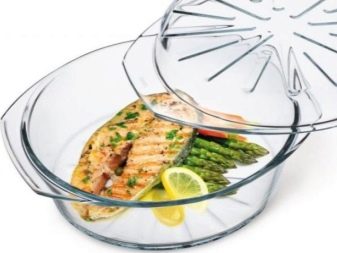
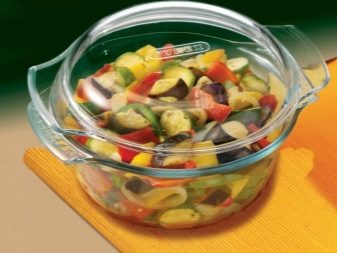
Purpose and Scope
There is a classification of glassware, based on which the pans are universal type or intended only for ovens and microwave ovens.
As a rule, the dishes have a standard cylindrical shape, so it will be suitable for cooking not only the first, but also the second dishes, some chefs use glass pans for cooking cakes and other baked goods. A glass pan with a deep lid can be used as a frying pan, as various products can be baked or stewed in the lid.
Thus, it will be possible to save, and instead of two products for the kitchen to purchase one.
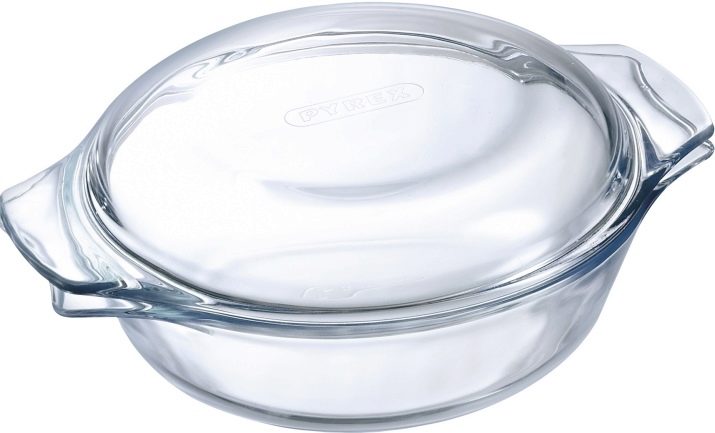
Thin-walled containers are used to serve cold soups or drinks on the table. Thick-walled dishes can be used directly for preparing various dishes. Glass sets usually consist of three items, different in size.
The volume of glass cookware varies from half a liter to 5 liters. The larger the volume, the heavier the product will be. As a rule, the volume of 2 or 3 liters will be the most convenient. Marking is carried out based on the diameter of the bottom of the tank, these values are from 14 to 26 centimeters.
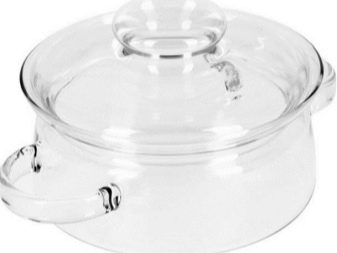
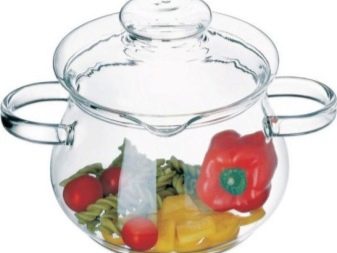
Criterias of choice
When choosing sets or individual pots for glass for operation, you should pay attention to the main characteristics of the proposed products.
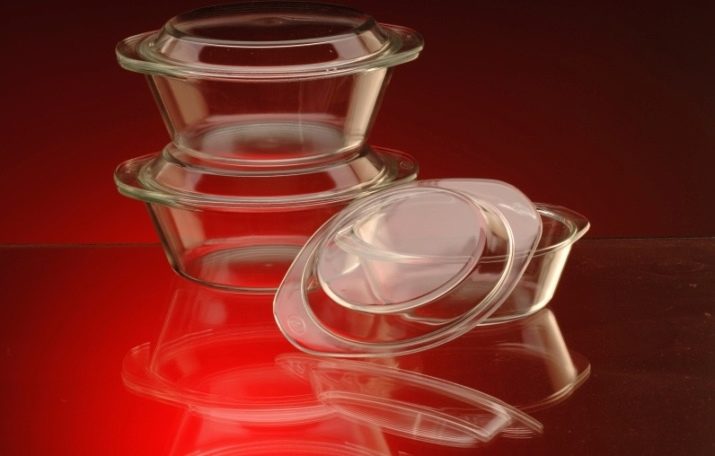
The quality and appearance of the walls and bottom
Tanks for cooking should not have defects regarding smoothness, as well as various bevels in the mold. Any hollows or waves will clearly indicate poor quality dishes.
Glass Features
Good refractory glass can be easily checked for compliance with established criteria. To do this, it is enough to bring the selected capacity to the light, in the sun a good material will be homogeneous, without any impurities and bubbles.

Acceptability of use with different plates
For an electric stove, polished glass pans are best suited. If the dishes will be used on different cooking surfaces, including the oven and microwave, in addition to the pots you will need to buy an induction divider or adapter. With it, glass containers will become universal. As practice shows, thick glassware is more suitable for a gas stove, similar products can be found in the assortment of domestic manufacturers, foreign brands are more focused on electric stoves.
For induction cookers, there are special varieties of containers made of glass that have a metal layer at the bottom that has magnetic properties.
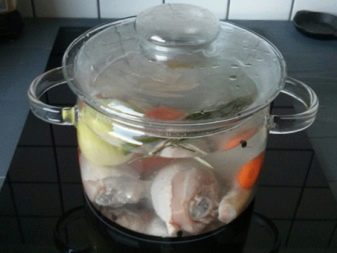

Burner shape
The size and circumference of the bottom of the glass pots should correspond to the area of the heating element on the stove.
Use in the oven
If in the future it is planned to use the kitchenware for cooking in the oven, then before buying it is worth examining the product information to make sure that the pan can be operated in this way. Absolutely heat-resistant glass cookware has not yet been invented, therefore, the compatibility and fire resistance of the proposed product should be considered first.
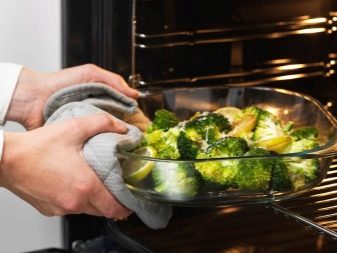
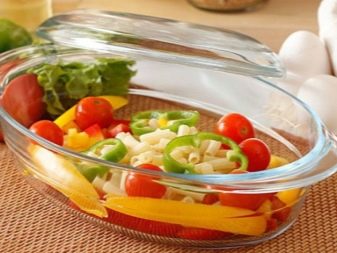
Recommendations for use
High-quality glass pans today are actively used for stewing, cooking, baking, heating food, preparing drinks and even baking. In the light of their multifunctionality, it is necessary to highlight certain rules regarding competent operation, which will extend the product's service life.
- If containers were purchased for cooking on a gas hob or stove, as well as for operation together with electric stoves, it is forbidden to put the pan on an open fire. For these purposes, you should always use a special adapter grid.
- Oval or rectangular pots are best used in ovens or microwave ovens, because round burners will not ensure uniform heating of the container over the entire area. In addition, glass has low thermal conductivity, which will significantly increase the time required for cooking. Uneven heating can not only spoil the food, but also lead to the fact that the container simply bursts on the stove.
- Do not heat an empty glass container.
- Regardless of the type of hob available, during cooking the outer walls of the pan should always be dry.
- To avoid burning foods at the bottom, it is necessary to ensure that a small layer of fat or liquid is present below.
- If a thick dish is being prepared, it should be stirred regularly so that the heat treatment process is uniform in all layers.
- If the recipe involves adding a certain amount of liquid to the prepared products, the pan must first be removed from the heat, and the liquid should be poured strictly in the center. A similar method will prevent it from reaching the red-hot walls of the tank, thereby preventing the formation of cracks from a sharp temperature drop.
- A pan removed from the fire should not be placed on a wet or cold surface. This applies to the use of dishes in the microwave, oven or on any stove. As a stand, it is recommended to use a board or a special silicone substrate for hot.
- The cooking process should take place on a slow fire, without sharp jumps in temperature, which can adversely affect the integrity of the glass.
- To mix the ingredients, it is necessary to use spoons, skimmers or spatulas made of silicone, plastic or wood. Metal objects are not recommended.
- Using glass pans, you need to fill containers with products no more than 60-70%.
- The handles of the heat-resistant dishes will heat up together with the entire capacity, therefore, during cooking, you need to additionally use kitchen potholders.
- It is forbidden to operate containers even with minor defects, since the glass can become even more deformed and split due to heating.
- Manufacturers usually label their products with special pictograms. Such designations will help to understand the nuances of the operation of glass pans, as well as their compatibility with stoves.
- Caring for dishes does not require the use of any specialized tools and compositions. After cooking or storing food, containers can be washed by hand or in the dishwasher.
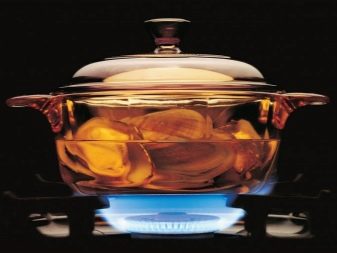
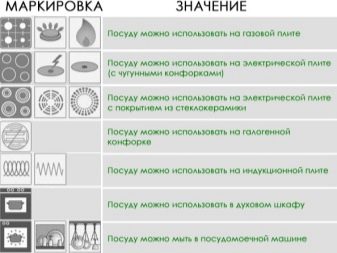
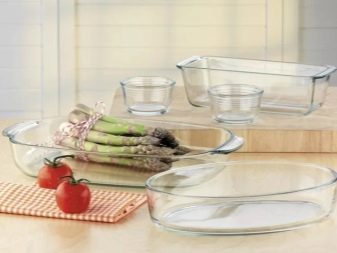
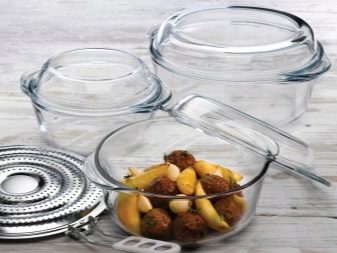
However, during the cleaning process, it is recommended to avoid abrasive powder products and brushes that can damage the smooth surface of the bottom and walls.
See the following video for an overview of the glass pan.
